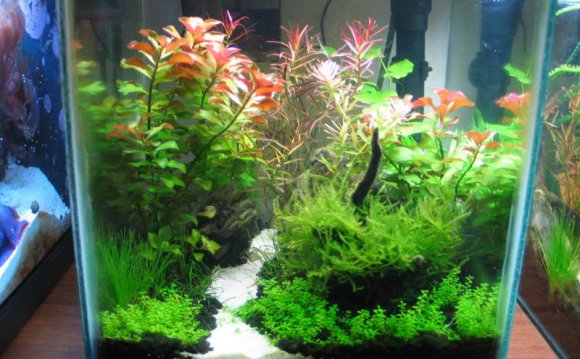
In this post Aquascapes share their expertise in setting up a planted betta tank. They go through what you need to think about for a perfect betta environment that looks beautiful. It’s a great article please read on…
The Betta genus encompasses a huge variety of fish however many of you will probably own a variant of the Betta splenden. For this reason we will focus this article mostly on this group of species, however the ideas drawn from this article can be applied to virtually any Betta tank as the care requirements between species are very similar.
What should your goals be for your aquarium? For a successful planted setup you should be considering the needs of your inhabitants at all times – so I guess we should be asking what are the key requirements of a Betta tank?
– The long fins of the Betta make swimming in strong flow difficult and because a high rate of flow is emphasized as a need in the high-tech planted aquarium we should rule out plants that are considered ‘difficult’.
– Something else we should consider is the natural habitat of our fish. Most Bettas are found in sluggish waters like swamps, rice fields and road side ditches. These environments are often shaded by trees and vegetation; we can try to incorporate this into our design.
Apart from that these are very easy fish to keep alongside plants. For the health of the fish and ease of maintenance I would not recommend anything smaller than a 5 gallon – just recently some very nice nano aquariums have come on to the market that would suit this kind of setup.
Here is what I would look at using as my hardware:
– 5 gallon minimum tank
– Air powered sponge filter
So let’s now look at some plants.
Plant selection

Given what we have just learned about the betta’s natural environment, I would suggest some nice floating plants like ‘amazon frogbit’ Limnobium laevigatum or the more common Salvinia natans. These plants will serve two purposes, the first is to provide shade for your fish putting it more at ease, the second is relevant if you want to breed your fish – the root hairs of these floating plants provide a good structure for your fish to construct his bubble nest. Depending on the size of your tank you could select some of the lilies; Nymphaea stellata is a nice small one and produces nice red leaves.
With all this shade we must be more selective in choosing our other plants. Various Cryptocoryne species would provide a nice foreground/ midground plant, these generally do very well in low light conditions and are quite undemanding. Non red Hygrophilla species such as H.polysperma or H.difformis are a good choice for background plants; they grow quickly, so help with removing nitrate from the water and also can be cut and re-planted making them great space fillers.
If you have rocks and wood in your aquarium then tying mosses and ferns onto it can create a really nice effect; I would suggest Taxiphyllum barbieri and Microsorum pteropus these are very undemanding and besides a little trimming of the moss you can leave them alone.
I suggest starting off with some of these easy plants to build your confidence in growing plants, then you can move onto something more challenging.
Setting up your aquarium
Here we will not discuss the basics of setting up your aquarium like cycling your filter. Information on general setup can be found in the Aquascapes.info directory. Here we will look at the cosmetics of setting up your tank.
– The substrate – sand is a good choice for a beginner’s aquarium. Aim for around 2 inches of depth and if your wanting to grow some Cryptocorynes then push some root tabs into the sand, these will provide nutrition for the plants at their roots.
– Now you want to add your heater and filter
– Once you have your substrate in the tank then you should add your rocks and wood, if using rocks I would recommend using different sizes but do try to use the same type of rock. Make sure your rock is inert (does not change water chemistry) and use it to add height at the back of the aquarium. Now is the time to tie the mosses and ferns onto the wood or rock (make sure you keep spraying these plants with water to stop them drying out whilst you continue your setup).









